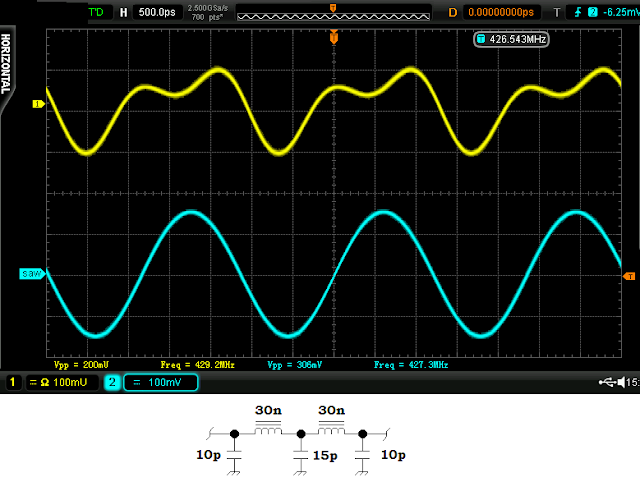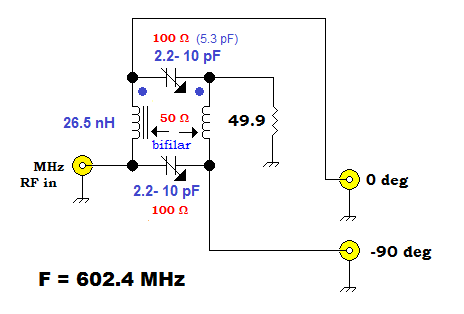I've spent >1 month studying frequency synthesis — a big subject that covers topics from writing code, to applying ECL + TTL logic — and finally making VCOs at VHF-UHF.
Some builders will buy a "1 and done IC" like the Si570, and that's great — but through QRPHB, I attempt to dive into more 'organic' design work @ the component level. It's great fun to play with prescalers, charge pumps, different order and styles of loop low-pass filters, phase and/or frequency comparators and the various schemes to divide down the feedback and reference frequencies. The theory and math in PLL loop filter design also challenges you. To me, the PLL = the ultimate challenging circuit to play with and learn about.
Also, over time, I hope to eventually develop up to ~10 GHz frequency synthesizers for my mostly ZIF receivers, but that's a long way off. Today, I'll focus on a UHF VCO and how some of the bypass caps and inductors were chosen to keep it stable.
Above — the discussion prototype VCO. You'll find this JFET VCO topology in newer Kenwood and Icom transceivers that give coverage into UHF. These radios use a PLL chip (such as the LMX2306) with an external PLL low-pass filter and VCO. Moving the loop filter and VCO off-chip presumably allows the engineers to lower VCO phase noise and to optimize the loop filter for various parameters including synthesizer phase noise. Further, for phase noise reduction, designers keep the VCO gain low but get a decent tuning range with higher reverse DC voltage applied to discrete varactors.
Since I'm using this VCO as the heart of a signal generator, my buffer design remains under development — 1 signal gets low-pass filtered and then boosted to around +7 dBm for the VCO output, while the other gets boosted and goes to a ECL prescaler and then further divided by TTL logic in or outside a PLL chip. I'm still seeking the best strategy, but MMICs seem the easiest way to boost the signal level outside the VCO's metal container.
This VCO topology can easily tune >=30 MHz tuning bandwidth (from a 5-10 VDC PLL output), but in microwave terms it = a low bandwidth VCO. I don't have a need for a 1 octave VCO presently and lower bandwidth allows for the use of a higher Q, single turn, u-shaped loop of wire for the inductor + avoids the need for a frequency doubler for up to ~ 570 MHz from my experiments. I've built this VCO with both leaded and SMT JFETS. Cx varies the tuning bandwidth, however, @ UHF, stray capacitance weighs heavily along with your capacitor choices to determine the tuning range and signal amplitude. Even changing buffer circuit values may affect the oscillator function.
I built on double sided copper clad board with numerous copper via wires connecting the 2 surfaces. RF tight shielding and mechanical stability also factor.
Above —The 2 channels along with the low pass filter shown applied to the (blue) main VCO output channel. The yellow channel gets digitized in an ECL pre-scaler chip and the frequencies tracked well.
Above — Blue or main VCO output channel in a spectrum analyzer to look at the 2nd harmonic @ 808 MHz [ -43.7 dBc ]
Bypass Capacitor
Which capacitor value to choose for RF bypass at ~400 MHz? With a tracking generator and spectrum analyzer, I swept a 100 pF capacitor.
Above — A size 0805 AVX 100 pF capacitor swept to determine its series resonant frequency. SRF = ~361 MHz with a 44.4 dB deep notch.
Wes sent me a bag of these ~ 8 years ago and they deliver a good notch (at UHF) due to a Q >=500 @ 1 MHz. A couple no-name 100 pF capacitors bought on a popular online auction site showed a notch depth of on only -35 to 36 dB due to their poor Q. I won't buy any capacitors that lack a datasheet and always sweep a few to confirm the datasheet specification.
Because they generally go with a series inductor and/or a resistor as a low-pass filter — even though the SRF lies less than 400 MHz — they will work OK.
For pure RF bypass alone, a smaller capacitor value such as 82 pF might make a better choice due to the SRF of this 100p cap @ ~ 361 MHz. Further, to raise the SRF, you can also go to a smaller capacitor package like 0603, but that's getting small for the over 50 builder with presbyopia. One 100pF, Johansen size 0603 cap in my collection exhibits a SRF of ~475 MHz at a notch depth of -44 dB.
Above — A sweep of a size 0805 "ultra high Q" Vishay cap. Special high Q caps get expensive — and I normally reserve them for bandpass filters and applications where I'm really going for Q. The notch lies 5.36 dB deeper than the AVX capacitors shown above. Normally, you'll see a notch boost of 8-10 dB with a special "high Q" SMT cap compared to a garden variety SMT cap. This shows that those AVX caps Wes sent me are quite good and suitable for my work.
Above — A sweep of a leaded MuRata MLCC 50v C0G capacitor with the leads cut quite short. The SRF dropped by ~ 131 MHz.
In my VCO schematic, the JFET drain DC voltage needs power supply decoupling and filtration. A series 470 nH choke and a 51 Ω resistor bypassed by 2 different cap values serves that function. Here's some experimental details of the individual components and — then finally, the finished network:
Chokes
Above — A sweep of a through-hole, low Q ( less than 30 @ 1 MHz ) axial 1 µH axial RF choke. You see these a lot in homebrew radio projects. They resemble a color-coded resistor and work ~ OK at HF in some applications.
No deep notch. Note the generally shallow wideband response so typical of these @ VHF - UHF. We seek something with a little more Q up at UHF.
Above — A sweep of a 470 nH wire wound SMT choke that exhibits a 49 dB notch at 292 MHz. This wire wound choke's self-capacitance drops the SRF well below our target of 400 MHz. I've noticed from sweeping many chokes that the nH value often precludes intuition of the SRF. For example, a 68 nH device may exhibit a lower SRF than a 220 nH device. Things really vary from manufacture to manufacturer. For chokes at UHF, I've learned all that really matters = SRF and Q — and a datasheet and/or a sweep is the only way to learn this.
Above — A sweep of a wire wound 220 nH Coilcraft coil from my collection. Beautiful part!
Above — A snippet from a Coilcraft datasheet. Based on the performance of the 220 nH choke shown just above, I ordered 100 of the 330 and 470 nH values today. Note the stout maximum current — these will work well for MMIC decoupling too.
Pi filters
As mentioned, for filtering our DC lines, we usually apply series resistors or chokes plus bypass capacitors.
Above — A sweep of the pi filter: the 100 pF bypass cap on either side of a 51 Ω resistor. The deepest notch lies at ~223 MHz. while this filter may work OK --- how might we boost the notch and filter bandwidth?
Above — A sweep the pi filter with 1 capacitor increased to .001 µF This boosted the bandwidth + the attenuation at ~ 400 MHz. Further, we've extended the attenuation to 128 MHz with a notch of 41 dB.
This gets you thinking. If we combine the filter above with a series choke exhibiting a reasonable Q at UHF — can we extend both attenuation and bandwidth?
Above — Yes. A sweep of the FET drain DC supply filter applied in the 400 MHz VCO shown in the first figure. By combining the series resistor, choke with decent Q and 2 different bypass cap values, a really nice filter emerged. Love this.
Further, 220 µF caps lie in shunt with the 1 nF RF capacitors on the DC rail. I boosted the 1K resistor to 1K to limit FET current and this further drops the filters' lower 3 dB cutoff @ AF + RF.
The end result = a well filtered DC rail. AF ripple can modulate the VCO and RF parasitics could also add unwanted modulation or noise + instability.
One problem still vexes me: my 470 nH choke with a SRF of 292 MHz gets applied as the DC return path for the varactor anode and on the FET drain. I really want the SRF closer to 400 MHz (just above is better). For the varactor DC return, a high value resistor might work. Further, I could just wait until my ordered Coilcraft 330 + 470 nH chokes arrive. I can't wait to sweep these parts.
Above — A sweep of a source resistor (originally 150 Ω) and choke that goes on the FET source lead. I'm losing a little signal to ground due to less than ideal attenuation @ 400 MHz, however by raising the resistor to 390 Ω, losses were minimized I can adjust the FET current by tweaking the drain resistor when I bias each FET in this VCO design.
Measurement and problem solving on the bench poses my favorite activities in this hobby.
Thank you!
QRP-PosData --- January 5, 2016 --- Miscellaneous
Above — Synthesizer / PLL books. For basic PLL math and theory, anything by Roland Best will help you. I also enjoy the blue book shown written by P.V. Brennan. In Introduction to Radio Frequency Design, Wes, W7ZOI wrote a great chapter on frequency synthesis for those who need a good primer (now out of print).
Above and below— MC145151. I'm always about 2-3 decades too late in this hobby. But the fun never stops with these relics. I only build to better understand electronic design — and not just to make stuff.
Above —My pre-scaler and MCU collection slowly grows. You might not imagine how much fun + learning these parts provide.
Above and below— Example discrete circuitry experiments I'm working with to learn the ropes.




































































